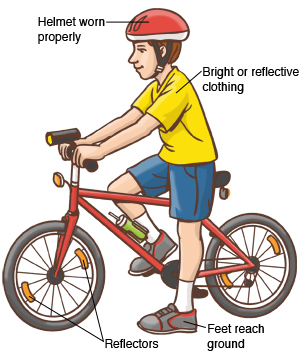The first rule of bicycle safety is to wear a helmet. Trauma is a leading cause of death in children, and head injuries from bike accidents are very common.
These are some tips for your child's safety when riding a bicycle. Set aside some time to discuss these with your child. Help your child understand how to prevent injuries.
-
Always wear a helmet that fits correctly and is made for bicycle riding. The straps should be fastened.
-
Learn the rules of the road. Older children should ride in the street, on the right-hand side, in the direction of traffic. Ride in a single line, staying close to the curb. Use hand signals when turning.
-
Watch for obstacles. These include wet leaves, branches, puddles, uneven road, storm grates, gravel or rocks, and curbs.
-
Watch for doors opening on parked cars.
-
Keep both hands on the handlebars and both feet on the pedals.
-
Stop at all stop signs, intersections, and traffic lights. Walk bikes through busy streets and intersections.
-
Use hand signals when turning or stopping.
-
Don't ride over drain grates, potholes, loose dirt, gravel, or oil slicks.
-
Don't try to carry a second person on your bike.
-
Carrying heavy packages, backpacks, and books on a bicycle may cause the loss of control and falling.
-
Give walkers the right of way.
-
Watch for parked cars backing up, backing out of driveways, opening doors in front of you, or pulling out into traffic.
-
Never hitch a ride by holding onto a moving car or motorcycle.
-
Be sure nothing will get caught in the chain, such as loose pants, backpack straps, or shoelaces. Wear closed-toe shoes while riding. Sandals and flip-flops or shoes with cleats may slip off the pedal. Never ride barefoot.
-
Children should never ride a bike at night or at dusk. Nighttime riding needs special skills and bicycle safety equipment. Most children don't have these.
-
Keep bikes adjusted and in good working condition. Check tire pressure and brakes on a regular basis.
-
Don't wear earphones when riding. This might prevent you from hearing car horns.
-
Don't use electronic devices, such as cell phones, while biking,
-
When passing people or other bikers, pass on their left side. Call out "On your left." This helps people know what you're doing. Then they won't run into you while trying to get out of your way.
Featured in


